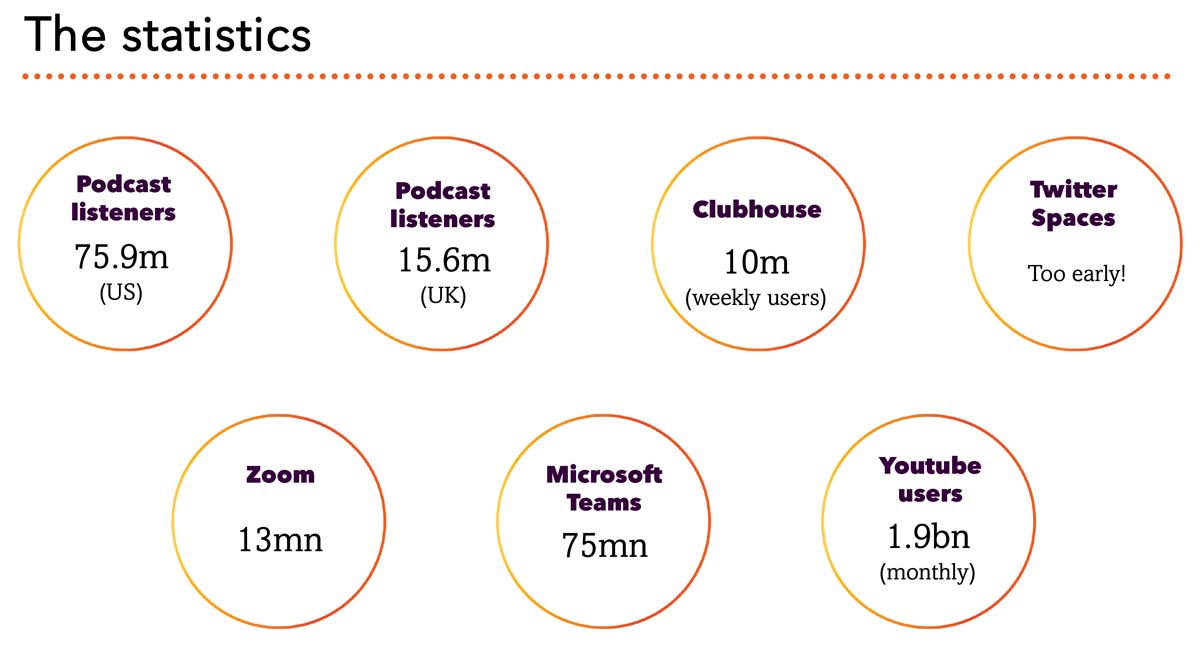Published 25th May 2021
 Our May Inside Stories virtual event featured leading communications professional Jenni Field, Founder and Director of Redefining Communications. Jenni is a former President and fellow of the Chartered Institute of Public Relations (CIPR), and specialises in helping organisations go from chaos to calm; helping teams work together better and operations to work more efficiently.
Our May Inside Stories virtual event featured leading communications professional Jenni Field, Founder and Director of Redefining Communications. Jenni is a former President and fellow of the Chartered Institute of Public Relations (CIPR), and specialises in helping organisations go from chaos to calm; helping teams work together better and operations to work more efficiently.
Jenni’s presentation focused on the latest developments in interactive audio and video channels and explained their continuing importance for our teams and clients.
Covid has changed the landscape of communications so it is essential that we embrace and understand these new communication channels, whether we remain working from home or operate in a hybrid working environment
The popularity of video inside and outside
- There are over 1.9 billion active YouTube users each month
- People watch an average of five billion YouTube videos every day
- People upload more than 500 hours of video on YouTube every minute
- You Tube is the second most visited website globally after Google
- In 2020, Zoom grew from 659,000 users to 13 million
- Microsoft Teams grew from 20 million users in November 2019 to 75 million in April 2020
Zoom fatigue
Jeremy Bailenson, a professor of communication at Stanford University identified four reasons for video calls causing fatigue and draining energy:
- The excessive amount of intense, prolonged eye-contact
- Increased self-evaluation from seeing ourselves on screen
- The lack of mobility
- The increased “cognitive load” required to interpret virtual gestures and other nonverbal clues.
This is the same for any video conferencing platform but there are things you can do to overcome it. One of those things is running effective meetings – governance is key
to the growth across both audio
This is the same for any video conferencing platform but there are things you can do to overcome it. One of those things is running effective meetings – governance is key.
Top tips for running effective online meetings
- Define the purpose
- Listen
- Have the right people in the virtual room
- Contract behaviour
- Set an agenda
- Be clear on deadlines and actions
- Facilitating online meetings
Where has the growth for Audio come from?
Podcasts have fuelled the growth of audio and this has been driven by advertising investments and smart phone technology enabling better access to content
- The increase in use of smart phones has been the main driver for growth in audio channels
- Combined with pace of life and the desire for good stories, audio is coming through as a channel of choice for many
- Audio books while you walk, podcasts while you drive – the ease of access is what drives consumers to it
We respond differently to audio and video
- We respond different to audio and video – but that doesn’t mean video is better
- Our imagination is heightened when we listen to audio without video
- In fact, we pay more attention so a phone call will often make you listen more than a video call
- Data also tells us that text is making us feel more disconnected. Video has a role to play but audio can be just as good at enabling connections
 What is Clubhouse?
What is Clubhouse?
Clubhouse is an audio only app that is only available to those with an Apple phone and it is invite only. It is like listening to a live podcast where you can join in and be part of the conversation.
You can follow people and have 1:1 or 1: many conversations
Why use it?
- Access to people you wouldn’t usually interact with and a different group from other, more established social channels.
- If you/your brand is better in audio/video then it’s a great place to explore.
What is Twitter Spaces?
Available for those with over 600 followers, Spaces allows you to host and share audio content through Twitter.
Only available on smartphones, not through the web. You can ask to speak and take part in the conversation too.
Still very new!
Why use it?
- If you have a good community on Twitter it’s another way to connect with them in a more personal way
Data, privacy, risk of live audio
- Twitter Spaces will record and store the conversation for up to 30 days to manage any complaints or platform violations – they have plans to do more for the hosts in spaces
- Clubhouse deletes the recording as soon as the room closes
- Separate data questions over the access to Clubhouse and access to individual contacts on people’s phones
- Verification is tricky – people can say they are anybody and the ability to verify expertise is a risk
- Remember it’s not inclusive – not everyone can hear and not everyone can access the content so always think about how it fits with other channels
Content should always come first
- There should always be a reason for the channel being used
- Have as strategy and a reason behind why you are using it, how you will measure it and what you want to get from it
- Explore the new channels and see if they fit for you and your brand
- Audio is going to grow and will continue to rise in terms of listeners and advertising spend
- The channel to be mindful of is text based only – like Slack
Consider the rhythm of your organisation
- A crisis will be a catalyst for a trend–audio was already growing; the pandemic will escalate that trend and make things happen faster
- Equally, in a crisis, we will lift and shift. This isn’t a long-term solution and when it comes to channels for communication, there needs to be a long-term view and a more strategic approach
- Think magazine to online PDF to something different …
View more information and discussion on the Rise of Audio Channels here.






